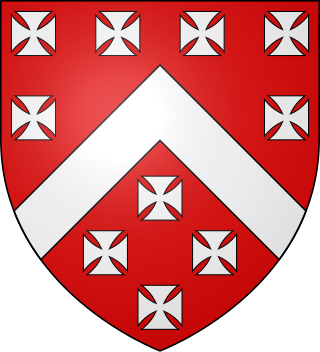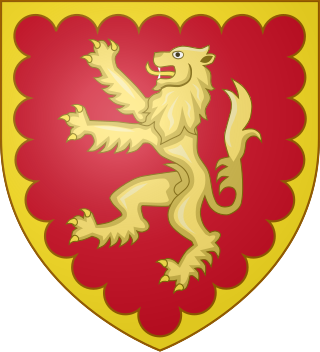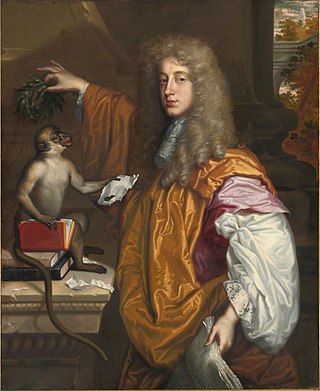Duke of Buckingham, referring to Buckingham, is an extinct title that has been created several times in the peerages of England, Great Britain, and the United Kingdom. There were creations of double dukedoms of Buckingham and Normanby and of Buckingham and Chandos. The last holder of the dukedom died in 1889.

Marquess Conyngham, of the County of Donegal, is a title in the Peerage of Ireland. It was created in 1816 for Henry Conyngham, 1st Earl Conyngham. He was the great-nephew of another Henry Conyngham, 1st Earl Conyngham, a member of a family of Scottish descent which had settled during the Plantation of Ulster in County Donegal in Ireland in the early 17th century. The 'founder' of the dynasty in Ireland was The Very Rev. Dr. Alexander Cunningham, Dean of Raphoe. The earlier Henry was a member of both the Irish House of Commons and the British House of Commons and served as Vice-Admiral of Ulster and as Governor of the counties of Donegal and Londonderry. In 1753 he was raised to the Peerage of Ireland as Baron Conyngham, of Mount Charles in the County of Donegal, and in 1756 he was created Viscount Conyngham, in Ireland, also in the Peerage of Ireland. In 1781 he was made Baron Conyngham, of Mount Charles in the County of Donegal, with remainder to his nephew Francis Burton, and Earl Conyngham, of Mount Charles in the County of Donegal, which like the creations of 1753 and 1756 was created with normal remainder to the heirs male of his body. The latter titles were also in the Peerage of Ireland. Lord Conyngham was childless and on his death in 1781 the barony of 1753, the viscountcy and earldom became extinct while he was succeeded in the barony of 1781 according to the special remainder by his aforementioned nephew Francis. He was the eldest son of Mary, sister of the first Earl Conyngham, by her husband Francis Burton. The new 2nd Baron Conyngham, who had earlier represented Killybegs and County Clare in the Irish House of Commons, assumed by Royal licence the surname and arms of Conyngham on succeeding to the titles.

Earl of Malmesbury is a title in the Peerage of Great Britain. It was created in 1800 for the diplomat James Harris, 1st Baron Malmesbury. The son of the grammarian and politician James Harris, he served as Ambassador to Spain, Prussia, Russia and France and also represented Christchurch in the House of Commons. Harris had been created Baron Malmesbury, of Malmesbury in the County of Wiltshire, in 1788. He was made Viscount FitzHarris, of Hurn Court in the County of Southampton, at the same time as he was given the earldom. The earldom and viscountcy were the last creations in the peerage of Great Britain, future titles being made in the peerage of the United Kingdom which took effect three days later.

Earl of Halifax is a title that has been created four times in British history—once in the Peerage of England, twice in the Peerage of Great Britain, and once in the Peerage of the United Kingdom. The name of the peerage refers to Halifax, West Yorkshire.

The title Baron Berkeley originated as a feudal title and was subsequently created twice in the Peerage of England by writ. It was first granted by writ to Thomas de Berkeley, 1st Baron Berkeley (1245–1321), 6th feudal Baron Berkeley, in 1295, but the title of that creation became extinct at the death of his great-great-grandson, the fifth Baron by writ, when no male heirs to the barony by writ remained, although the feudal barony continued. The next creation by writ was in 1421, for the last baron's nephew and heir James Berkeley. His son and successor William was created Viscount Berkeley in 1481, Earl of Nottingham in 1483, and Marquess of Berkeley in 1488. He had no surviving male issue, so the Marquessate and his other non-inherited titles became extinct on his death in 1491, whilst the barony passed de jure to his younger brother Maurice. However, William had disinherited Maurice because he considered him to have brought shame on the noble House of Berkeley by marrying beneath his status to Isabel, daughter of Philip Mead of Wraxhall, an Alderman and Mayor of Bristol. Instead, he bequeathed the castle, lands and lordships comprising the Barony of Berkeley to King Henry VII and his heirs male, failing which to descend to William's own rightful heirs. Thus on the death of King Edward VI in 1553, Henry VII's unmarried grandson, the Berkeley inheritance returned to the family. Therefore, Maurice and his descendants from 1492 to 1553 were de jure barons only, until the return of the title to the senior heir Henry, becoming de facto 7th Baron in 1553. Upon his death he was succeeded by his relative George Harding.

Viscount Falmouth is a title that has been created twice, first in the Peerage of England, and then in the Peerage of Great Britain. The first creation came in the Peerage of England in 1674 for George FitzRoy, an illegitimate son of King Charles II by Barbara Villiers. He was created Earl of Northumberland at the same time and in 1683 he was made Duke of Northumberland. However, he left no heirs, so the titles became extinct at his death in 1716.

Baron le Despencer is a title that has been created several times by writ in the Peerage of England.

Earl of Kingston is a title in the Peerage of Ireland. It was created in 1768 for Edward King, 1st Viscount Kingston. The Earl holds the subsidiary titles Baron Kingston, of Rockingham in the County of Roscommon, Viscount Kingston, of Kingsborough in the County of Sligo, Baron Erris, of Boyle in the County of Roscommon, and Viscount Lorton, of Boyle in the County of Roscommon, also in the Peerage of Ireland. He is also a baronet in the Baronetage of Ireland. Between 1821 and 1869 the earls also held the title Baron Kingston, of Mitchelstown in the County of Cork, in the Peerage of the United Kingdom.

Earl Howe is a title that has been created twice in British history, for members of the Howe and Curzon-Howe family respectively. The first creation, in the Peerage of Great Britain, was in 1788 for Richard Howe, 4th Viscount Howe, but it became extinct upon his death in 1799. The second creation, in the Peerage of the United Kingdom, was in 1821 for Richard Curzon-Howe, 2nd Viscount Curzon, and it remains extant.

Earl of Strafford is a title that has been created three times in English and British history.

Baron Sheffield is a title that has been created four times: once in the Peerage of England, twice in the Peerage of Ireland, and once in the Peerage of the United Kingdom.

Viscount Grandison, of Limerick, is a title in the Peerage of Ireland. It was created in 1620 for Sir Oliver St John, the Lord Deputy of Ireland. He was the descendant and namesake of Oliver St John, whose elder brother Sir John St John was the ancestor of the Barons St John of Bletso and the Earls of Bolingbroke. Moreover, St John's nephew Sir John St John, 1st Baronet, of Lydiard Tregoze, was the ancestor of the Viscounts Bolingbroke and the Viscounts St John.

Viscount Newark is a title that has been created twice in British history, each time with the subsidiary title of Baron Pierrepont.

The title of Viscount Lisle has been created six times in the Peerage of England. The first creation, on 30 October 1451, was for John Talbot, 1st Baron Lisle. Upon the death of his son Thomas at the Battle of Nibley Green in 1470, the viscountcy became extinct and the barony abeyant.

Earl Cornwallis was a title in the Peerage of Great Britain. It was created in 1753 for Charles Cornwallis, 5th Baron Cornwallis. The second Earl was created Marquess Cornwallis but this title became extinct in 1823, while the earldom and its subsidiary titles became extinct in 1852. The Cornwallis family descended from Frederick Cornwallis, who represented Eye and Ipswich in the House of Commons. He was created a Baronet in the Baronetage of England in 1627 and Baron Cornwallis, of Eye in the County of Suffolk, in the Peerage of England in 1661. He was succeeded by his son, the second Baron, who also sat as Member of Parliament for Eye. On his death, the titles passed to his son, the third Baron. He notably served as First Lord of the Admiralty. His son, the fourth Baron, was Lord Lieutenant of Suffolk and Postmaster General.

Earl of Rochester was a title that was created twice in the Peerage of England. The first creation came in 1652 in favour of the Royalist soldier Henry Wilmot, 2nd Viscount Wilmot. He had already been created Baron Wilmot, of Adderbury in the County of Oxford, in 1643, also in the Peerage of England. He was the son of Charles Wilmot, who had been elevated to the Peerage of Ireland as Viscount Wilmot, of Athlone, in 1622. Lord Rochester died in 1658 and was succeeded by his son John Wilmot, 2nd Earl of Rochester. He was a poet, a friend of King Charles II, and the writer of satirical and bawdy poetry. He married the heiress Elizabeth Malet. He was succeeded on his death in 1680 by his only son, the third Earl. He, in turn, died at a young age the following year, when the titles became extinct.

Baron Berkeley of Stratton, in the County of Cornwall, was a title in the Peerage of England. It was created in 1658 for John Berkeley, 1st Baron Berkeley of Stratton, a Royalist during the Civil War who had distinguished himself at the Battle of Stratton, fought in 1643 at Stratton in Cornwall. He was a member of the Berkeley family of Bruton in Somerset, descended from Sir Maurice de Berkeley, a younger son of Maurice de Berkeley, 2nd Baron Berkeley (1271–1326) of Berkeley Castle in Gloucestershire, the senior line of the Berkeley family. His brother was Charles Berkeley, 2nd Viscount Fitzhardinge and his nephew was Charles Berkeley, 1st Earl of Falmouth. The 1st Baron's second son, the 3rd Baron, was an Admiral in the Royal Navy who died without surviving issue and was succeeded by his younger brother, the 4th Baron, who served as First Lord of Trade between 1714 and 1715.

Viscount Fitzhardinge is an extinct title in the Peerage of Ireland. It was created on 14 July 1663 for Charles Berkeley, later Earl of Falmouth, of the Bruton branch of the Berkeley family, with the subsidiary title of Baron Berkeley of Rathdowne, also in the Peerage of Ireland. It passed by special remainder to Charles' father, Charles, then to Maurice, elder brother of the first viscount, and then to their younger brother, John. The title became extinct on John's death in 1712.

Charles Berkeley, 1st Earl of Falmouth was an English nobleman and naval officer who was the son of Charles Berkeley (1599–1668) and his wife Penelope née Godolphin, of the Bruton branch of the Berkeley family.
George Henry Boscawen, 2nd Earl of Falmouth, styled Lord Boscawen-Rose between 1821 and 1841, was a British peer and politician.
















